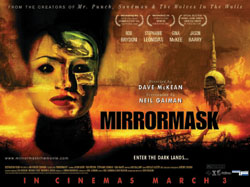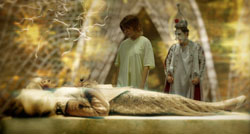
Neil Gaiman and David McKean (of Sandman graphic novel fame) have teamed up with The Jim Henson Company (of Muppets and Labyrinth fame) to create a modern fantasy tale aimed as much at older children as adults.
The story is about 15-year old Helena, (played by Stephanie Leonidas who, interestingly, has more than a passing resemblance to a young Helena Bonham-Carter), the daughter of circus-owning parents played by Gina McKee and Rob Brydon (currently getting rave reviews for his part in A Cock and Bull Story). Stephen Fry and Lenny Henry (who produced Gaiman’s Neverwhere series) do cameo voice-over spots. In a reversal of the usual premise, Helena wants to runaway from the circus as she feels her parents don’t understand her (well she is a teenager), and this is compounded by her precocious talent and vivd imagination. The opening of the film sees her indulging in her own fantasy world and refusing to perform in the family’s show, and getting into an argument with her mother about it, which leads to her saying those typical angst-ridden teenager’s words, “I wish you were dead.” Although the wish doesn’t come true, events take a turn that make her wish she hadn’t uttered those words. During a night when she is feeling regret, Helena is awakened by the sound of a violin, which she goes to investigate, and finds herself entering into a place that is being consumed by darkness, much like the land in Never Ending Story. It is her mission to find a cure for the sleeping White Queen before the Black Queen consumes everything.
 If the reference to White and Black Queens conjures up memories of Lewis Carroll’s stories of Alice, there are definitely parallels and influences in the story, but most fantasy quests follow a similar format and structure because, like jazz, there is a framework within which the artist can improvise. Speaking of jazz, the soundtrack features modern jazz-fusion pieces as well as hybrid European folk and cabaret music, very eclectic and not necessarily to everyone’s taste, but it works very well with the visuals. If you are familiar with Gaiman and McKean’s work in Sandman or the 1990’s TV series Neverwhere, you will have some idea of this film’s story and visual content. With the Henson name attached to the film you can be assured of all manner of weird and wonderful creatures. These beasts are mostly digital creations and not the puppets Hensons are usually associated with. Like all contemporary fantasy films it is heavily imbued with digital effects but they are very well integrated with the elaborate costumes and McKean’s hand-drawn illustrations to create a surreal yet believable alternate world. Colour is used well in the film, from muted sepia tones to grainy, almost monochromatic, reportage-style shots to vibrantly coloured theatrical images, like those in Moulin Rouge.
If the reference to White and Black Queens conjures up memories of Lewis Carroll’s stories of Alice, there are definitely parallels and influences in the story, but most fantasy quests follow a similar format and structure because, like jazz, there is a framework within which the artist can improvise. Speaking of jazz, the soundtrack features modern jazz-fusion pieces as well as hybrid European folk and cabaret music, very eclectic and not necessarily to everyone’s taste, but it works very well with the visuals. If you are familiar with Gaiman and McKean’s work in Sandman or the 1990’s TV series Neverwhere, you will have some idea of this film’s story and visual content. With the Henson name attached to the film you can be assured of all manner of weird and wonderful creatures. These beasts are mostly digital creations and not the puppets Hensons are usually associated with. Like all contemporary fantasy films it is heavily imbued with digital effects but they are very well integrated with the elaborate costumes and McKean’s hand-drawn illustrations to create a surreal yet believable alternate world. Colour is used well in the film, from muted sepia tones to grainy, almost monochromatic, reportage-style shots to vibrantly coloured theatrical images, like those in Moulin Rouge.
 It would be unfair to say that this film has been heavily influenced by others, such as the works of Jan Svankmajer, the Quay Brothers, Terry Gilliam, Jean-Pierre Juenet, The Cell or even the paintings of Hieronymous Bosch, because McKean has established his own visual style over the years, but there is still something very familiar about the imagery used. This may simply be because they are archetypal dream images, and that familiarity is what helps to make us believe the story.
It would be unfair to say that this film has been heavily influenced by others, such as the works of Jan Svankmajer, the Quay Brothers, Terry Gilliam, Jean-Pierre Juenet, The Cell or even the paintings of Hieronymous Bosch, because McKean has established his own visual style over the years, but there is still something very familiar about the imagery used. This may simply be because they are archetypal dream images, and that familiarity is what helps to make us believe the story.
 The story is simple, as it supposed to be for children, which does not mean it is inane like a lot of kids’ films. It also has a complexity to it that will keep all age groups entranced. This isn’t a story for small children but one for the more precocious and visually aware. There are some moments that will startle you and also some very touching, emotional moments with Helena and her parents in the ‘real’ world. So if you want to take children to see a film that is infinitely more intelligent than the usual Hollywood junk, this is one you can go and enjoy, and even discuss with them afterwards. It is also a film that you can see without children, and unless they actually like the genre it is probably the best way to see it. If you like this style of visual storytelling it is one of the best to have come out in a long time.
The story is simple, as it supposed to be for children, which does not mean it is inane like a lot of kids’ films. It also has a complexity to it that will keep all age groups entranced. This isn’t a story for small children but one for the more precocious and visually aware. There are some moments that will startle you and also some very touching, emotional moments with Helena and her parents in the ‘real’ world. So if you want to take children to see a film that is infinitely more intelligent than the usual Hollywood junk, this is one you can go and enjoy, and even discuss with them afterwards. It is also a film that you can see without children, and unless they actually like the genre it is probably the best way to see it. If you like this style of visual storytelling it is one of the best to have come out in a long time.
An interview with with director Dave McKean can be read here.
 To celebrate the release of the film, Tartan Films have donated a copy of The Alchemy of MirrorMask, a glossy, hardcover book about the making of the film, filled with comments from the co-creators and lots of McKean’s stunning images. To win this beautiful book answer the following question: Co-writer, Neil Gaiman, wrote the English screenplay for which famous anime? There is a copy of Gaiman’s novel, American Gods, for the runner-up. E-mail your answer by March 10. DO NOT leave your answer or personal details in the comments box below as you will not be entered into the draw. One entry per household. Automated and bulk entries will be deleted.
To celebrate the release of the film, Tartan Films have donated a copy of The Alchemy of MirrorMask, a glossy, hardcover book about the making of the film, filled with comments from the co-creators and lots of McKean’s stunning images. To win this beautiful book answer the following question: Co-writer, Neil Gaiman, wrote the English screenplay for which famous anime? There is a copy of Gaiman’s novel, American Gods, for the runner-up. E-mail your answer by March 10. DO NOT leave your answer or personal details in the comments box below as you will not be entered into the draw. One entry per household. Automated and bulk entries will be deleted.
Release dates and venues
03.03.06 ICA, London
03.03.06 Ritzy, Brixton
03.03.06 Watershed, Bristol
03.03.06 Birimgham Star City
03.03.06 Cornerhouse Manchester
03.03.06 Showroom, Sheffield
03.03.06 Glasgow Renfrew
10.03.06 DOY, Brighton
10.03.06 Chapter, Cardiff
31.03.06 Picture House, Cambridge
